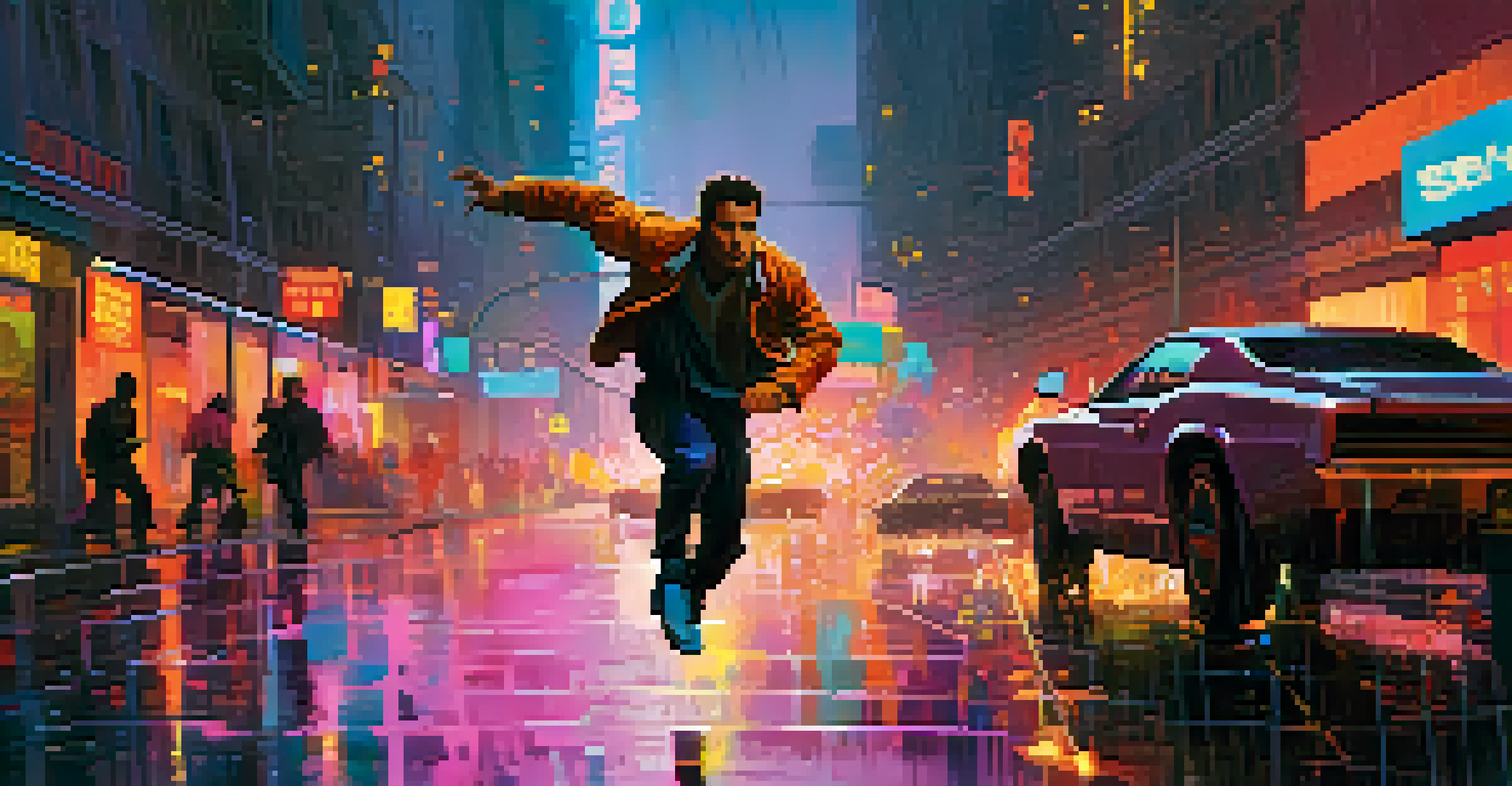The Importance of Storytelling in Film Trailers Explained

Understanding the Role of Film Trailers in Marketing
Film trailers serve as the first glimpse into a movie, acting as a marketing tool that aims to captivate potential viewers. They are designed to create buzz and anticipation, effectively building a connection between the audience and the film. Just like a well-crafted book cover, a trailer must entice viewers to want to know more about the story that lies within.
A trailer is like a first date: you want to leave them wanting more.
Trailers often condense the essence of a film into a short, engaging package, making it crucial for filmmakers to highlight the most compelling elements. This includes the plot, characters, and emotional stakes, all while adhering to a specific time limit. By doing so, trailers not only inform but also spark curiosity, leading to increased ticket sales and audience engagement.
The challenge lies in balancing information with intrigue; a successful trailer hints at the storyline without giving away too much. This delicate dance of storytelling in trailers is what keeps audiences glued to their screens, eager to learn more. Thus, understanding the role of storytelling in trailers is the first step to appreciating their impact.
The Power of Narrative in Capturing Audience Attention
At the heart of every great trailer is a compelling narrative that grabs the audience's attention. Just like in a good story, trailers need a hook that draws viewers in from the very first second. This could be an intriguing line of dialogue, a stunning visual, or even a pulse-pounding score that sets the tone for what’s to come.

Using narrative techniques, trailers can evoke emotions that resonate with viewers, making them more likely to connect with the film. For instance, a trailer that showcases a character's struggle can elicit empathy, while one that features high-stakes action can create excitement. These emotional triggers are essential in making the audience feel invested in the story before they even step into the theater.
Trailers Build Anticipation
Film trailers create excitement and curiosity, enticing viewers to learn more about the movie's story.
Moreover, a well-structured narrative within a trailer can effectively communicate the film's genre and themes. By weaving together key moments and visuals, filmmakers can provide a glimpse into the tone and style of the film, helping audiences determine if it aligns with their preferences. This strategic use of narrative is what makes trailers a powerful marketing tool.
Creating Emotion Through Visual Storytelling
Visual storytelling is a crucial aspect of film trailers, as images often speak louder than words. A carefully selected montage of visuals can convey the film's mood and themes without uttering a single line. For example, quick cuts of intense action scenes can create adrenaline, while slow-motion shots of poignant moments can evoke sadness or nostalgia.
The best trailers are those that leave you with more questions than answers.
In addition to visuals, color palettes and cinematography play a significant role in storytelling. Warm colors may evoke feelings of comfort and joy, while cooler tones might suggest mystery or tension. By thoughtfully combining these elements, trailers can create a visceral experience that lingers in the viewer's mind long after they've finished watching.
Furthermore, the pacing of the visuals is just as important as the content. A fast-paced trailer can build excitement, while a slower pace can create suspense or contemplation. This careful choreography of images and sounds helps to establish a narrative rhythm that mirrors the film's own storytelling style, making it an essential component of trailer creation.
The Impact of Sound and Music on Trailer Storytelling
Sound and music are integral to the storytelling process in film trailers. The right score can elevate the emotional resonance of a scene, drawing viewers into the narrative. Whether it’s an epic orchestral piece that builds tension or a haunting melody that evokes sadness, sound can profoundly affect how a trailer is perceived.
Moreover, sound effects can enhance the visual storytelling, adding depth to the overall experience. For instance, the sound of a heartbeat can amplify a moment of suspense, while the roar of an explosion can heighten excitement. These auditory elements work hand-in-hand with visuals to create a cohesive narrative that captures the audience's senses.
Visuals and Sound Drive Emotion
The combination of visuals and sound in trailers enhances storytelling by evoking strong emotions in the audience.
The combination of sound and visuals in trailers creates a multi-dimensional experience that leaves a lasting impression. Just like a great film, a trailer should engage not only the eyes but also the ears, making the storytelling richer and more immersive. This synergy between sound and storytelling is what makes trailers a compelling preview of the film.
Highlighting Key Characters to Build Connection
Character development is another vital aspect of storytelling in film trailers. By introducing key characters and their arcs, trailers can quickly establish a connection between the audience and the film. Viewers often relate to characters who mirror their own experiences or aspirations, making it essential to showcase these personalities effectively.
Through brief glimpses of dialogue and action, trailers can convey a character's motivations and struggles. This not only piques interest but also allows viewers to invest emotionally in the characters before the film even starts. For instance, a character faced with a moral dilemma can evoke empathy, making the audience eager to see how they navigate their challenges.
Additionally, the portrayal of relationships between characters can add layers to the narrative. Trailers that hint at friendships, rivalries, or romantic connections can create intrigue, prompting viewers to wonder about the dynamics at play. By highlighting these key characters, trailers can set the stage for deeper storytelling within the film.
Building Anticipation with Cliffhangers and Teasers
Cliffhangers and teasers are powerful storytelling techniques used in trailers to create anticipation. By leaving certain plot points unresolved, trailers can ignite curiosity, compelling viewers to seek answers by watching the film. This technique mirrors the way a well-written novel might leave readers eager for the next chapter.
For example, ending a trailer with a shocking revelation or an unanswered question can leave audiences buzzing with excitement. This sense of mystery can be a driving force behind ticket sales, as viewers are drawn to unravel the story that the trailer teases. It's a clever way to use storytelling to ensure that the film stays on the audience's radar.
Audience Feedback Shapes Trailers
Real-time audience reactions influence trailer content, allowing filmmakers to refine marketing strategies based on viewer preferences.
However, it’s essential to strike the right balance; too many cliffhangers can frustrate viewers rather than intrigue them. When used judiciously, these techniques can enhance the narrative, making the trailer a tantalizing glimpse into the film’s world. Ultimately, the goal is to leave audiences eager for more, building a strong desire to experience the complete story.
The Role of Audience Feedback in Shaping Trailer Storytelling
In today's digital age, audience feedback plays a significant role in shaping trailer storytelling. Social media platforms allow viewers to share their reactions almost instantly, providing filmmakers with valuable insights into what resonates and what falls flat. This real-time feedback can influence marketing strategies and even the final cut of the film.
For instance, if a trailer receives overwhelmingly positive feedback for a particular character or scene, filmmakers may choose to highlight that element more prominently in subsequent promotions. Conversely, negative reactions can prompt swift changes to avoid potential pitfalls. This dynamic relationship between creators and audiences adds an interactive layer to the storytelling process.

Moreover, analyzing audience engagement metrics can help filmmakers understand what aspects of the trailer capture attention. This data-driven approach allows for a more tailored storytelling strategy, ensuring that trailers not only reflect the film's narrative but also align with audience expectations. Ultimately, this collaborative storytelling effort enhances the overall movie experience.